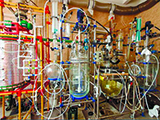
Scaling technologies for obtaining metal-containing liquid organic scintillers
• Purification of 3,5,5-trimethylhexanoate gadolinium was carried out by dissolution in tetrahydrofuran (THF) followed by filtration. At the same time, an insignificant amount of hydrolysis products that are part of the initial salt are separated, since they are not soluble in THF. THF is a cyclic ester, dissolves 3,5,5-trimethylhexanoate gadolinium well, solutions with a concentration of up to 100 g / l have a viscosity that allows filtering through filters of 5-8 microns. Since THF is a volatile and highly flammable liquid, all operations to move the solution were carried out using diaphragm pumps powered by compressed air. All the equipment used to work with TGF was explosion-proof.
• Gd(TMHA)3 solution purified from insoluble impurities was mixed with LAB in glass reactors with a volume of 100 liters equipped with a vacuum distillation system, the vapor condensers were cooled with water at a temperature of 5 °C. With a stepwise decrease in pressure and a temperature of 45-59 °C, and continuous transmission of high-purity argon through the solution, THF distillation was carried out. At the same time, a solution of gadolinium salt was formed in the LAB. The distilled THF after additional purification was again used in technological operations. After THF removal is completed (~23-25 hours) fluorescent components and DIN were added to the solution. Then the finished product was packaged in a stainless steel container with a volume of 200 liters in a protective argon atmosphere. The productivity of the periodic process ranged from 800 to 1200 liters per week. In total, more than 10,000 liters of scintillation solution were produced.


 ?
?